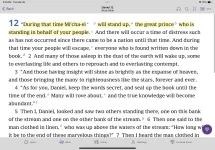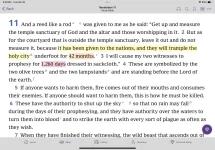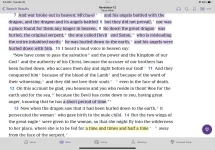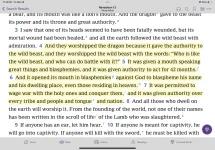14. 37
Introduction to
the End of the Age Discourse
The Disciples’ Question in Matthew 24:3
the End of the Age Discourse
The Disciples’ Question in Matthew 24:3
THE TEXT
“While he was sitting on the Mount of Olives, his disciples approached him in private saying, “Tell us when this is going to happen, and what will be the sign of your coming to be present as king and of the end of this age?”
COMMENTS
24:3a “Tell us when this is going to happen.”
This is a reference to the destruction of the second temple, but here Jesus is very unlikely to know that this event will happen specifically in A.D. 70. However, he does know that it will be sometime between the 69th and 70th ‘seven’ of Daniel 9:26-27 as one of the two events to occur within this gap of time after his ride into Jerusalem prior to his execution. So, because he doesn’t know when the second temple will be destroyed, he ignores this aspect of the question in verse 3, but later he answers the more important part of the question, namely, in the future “what will be the sign of your coming to be present as king and of the end of this age?”
24:3b “what will be the sign of your coming to be present as king and the end of this age.”
This is Jesus’ visible Parousia. It is not merely Jesus’ “presence,” for which one would need no sign, but is as N.T. Wright translates the Greek: “what will be the sign that you are going to appear as king.” However, the term Parousia is not used in the parallel accounts given in Mark 13 and Luke 21.
Furthermore, this is not the end of a so-called Jewish age, but is the end of this entire “present age”—the time of this world-order and will occur at the same time as the future return of Jesus and so did not occur A.D. 70 or any time in the past.
Why Luke 17 and 21 Run Approximately Parallel
to Matthew 24/Mark 13
Interestingly, scholars point out that Jesus’ prophecy in Luke 21, including his words in Luke 17, was not given on the Mount of Olives as was the case for Matthew 24:3ff/Mark 13:3ff, but given earlier in the temple. Indeed, the comments about the stones of the temple were made while Jesus and his disciples were still within the temple grounds and so Luke 21:5ff appears also to be a temple discourse rather than the one given on the Mount of Olives. Because of this detail and other differences between the accounts it has been stated by E. W. Bullinger, Robert Shank, and several other scholars that Luke 21:10-24 applies only to the events of A.D. 70. But is this correct?
Certainly, after the disciples have asked their question in Luke 21:7 of, “when will these things happen?” a careful reading of these two discourses shows that they are on precisely the same subject with one exception. This exception is that Luke 21:12 varies from Matthew 24:9 where Jesus says, “Then they will arrest you…,” whereas in Luke 21:12 Jesus says: “But before all these things they will lay their hands on you...” This gives the impression that the great tribulation comes before the events of, “Nation against nation etc” and is therefore out of sync with Matthew and Mark. This is solved when one realizes that the phrase, “But before all these things…” does take one back to the events of A.D. 70 concerning, “not one stone will be left on another” (vs. 6) to show how the disciples would be mistreated at that time. Nevertheless, this still concerns the future Great Tribulation. In other words, the A.D. 70 mistreatment of the disciples would become a pattern for the mistreatment of Christians during the Great Tribulation so that it is a double fulfilment of this persecution overview passage.
The following facts give sound reasons to believe that the temple discourse in Luke 17 and 21 concern the end-times:
Although expressed in a different order the details in Luke 17:23-37 closely parallel those in Matthew 24:23-41.
In Luke 21:20 Jesus says: “But when you see...Jerusalem surrounded by armies…” whereas Matthew and Mark put Jesus’ words as, “But when you see the sacrilege which causes desolation...” No doubt Jesus did say both sets of words but Luke has chosen the words that his Gentile readers would best understand; whereas Matthew’s and Mark’s Jewish readership would easily understand the reference to “the sacrilege which causes desolation.”
In Luke 21:21 Jesus says: “those in Judea must flee to the mountains” which is parallel to the Matthew 24 account. The pattern of Matthew 24:9-14 gives a general overview of the coming Great Tribulation and then verse 15 begins a detailed description of it, starting with “the sacrilege which causes desolation” as appearing at the mid-point of the Daniel’s 70th “seven” through to the end of this persecution (verse 28). Mark also follows this pattern.
Luke 21:22 shows, “that all things which are written will be fulfilled.” Although, the event that would be fulfilled in A.D. 70 was touched on in Daniel 9:26 the prophets generally concerned themselves with “the time of the end.” Daniel Chapters 8, 9, 11, and 12 are all primarily concerning the future Antichrist.
The Disciples’ Question in Luke 21:7
THE TEXT
“Teacher,” they asked him, “when will these things happen? And what will be the sign when these things are about to happen?”
COMMENTS
21:7a “Teacher, when will these things happen?”
Verse 7 is framed exactly as in Mark 13:4 and differs from the more detailed and precise version given in Matthew 24:3. However, this question in verse 7a is with reference to what Jesus had just commented on regarding the coming destruction of the Jerusalem temple, namely, “not one stone will be left on another” and which destructive event occurred in A.D. 70. Again, we note that Jesus is very unlikely to know that this event will happen specifically in A.D. 70, but does know that it will be sometime between the 69th and 70th ‘seven’ of Daniel 9:26-27 as one of the two events to occur within this undetermined gap of time before the 70th ‘seven’ begins. Please see the Appendix for the paper: The Destruction of the Second Jewish Temple.
21:7b “And what will be the sign when these things are about to happen?”
This is the more important part of the question to which Jesus responds through the rest of Luke 21. It corresponds to what is recorded in Matthew 24:3, namely, “what will be the sign of your coming to be present as king (Gk parousia) and of the end of this age?” i.e., the entire “present age”—the time of this world-order. It will occur at the same time as the future return of Jesus and so did not occur in A.D. 70.
These future events concerning the “signs in sun and moon and stars” are also noted in Luke 21:25-28 and connect to the events described in the passage of verses 20-24 about, “when you see Jerusalem surrounded by armies...” This means that the whole passage in Luke 21:8-36 is a single complex of events to occur in one time-period in the future. Similarly verse 27 begins with “and then they will see the Son of Man coming.” There is no good reason to interfere with the straightforward sequence expressed by Jesus in verses 20-28 by changing it to apply to A.D 70.
§





